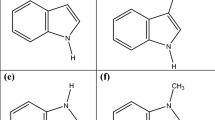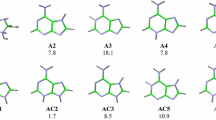Abstract
High-level ab initio quantum chemical calculations (G4(MP2)//MP2/6-311+G(2df,p)) have been used to examine homodimers of second-row bases, and to compare the results with those obtained previously for the first-row analogs. The relationship between the binding energies of the dimers and the proton affinities (PAs) of the bases follows the same pattern as that for the first-row systems, with the binding energies initially increasing with increasing proton affinity but subsequently decreasing. This may be attributed to the opposing effects of increased PA on the hydrogen-bond donor and hydrogen-bond acceptor. The binding energies are generally smaller for the second-row dimers than for the corresponding first-row dimers. There is an increased tendency for asymmetrical hydrogen bonds in homodimers of the second-row compared with first-row dimers. This may be attributed to the lower electronegativities of second-row atoms relative to their first-row counterparts, and to the longer internuclear separation between the hydrogen-bonded second-row atoms.







Similar content being viewed by others
References
Jeffrey GA (1997) An introduction to hydrogen bonding. Oxford University Press, New York
Scheiner S (ed) (1997) Hydrogen bonding: a theoretical perspective. Oxford University Press, New York
Scheiner S (1997) Molecular interactions: from van der Waals to strongly bound complexes. John Wiley and Sons, Chichester
Grabowski SJ (ed) (2006) Hydrogen bonding—new insights. Springer, Dordrecht
Buckingham AD, Del Bene JE, McDowell SAC (2008) Chem Phys Lett 463:1–10
Gilli G, Gilli P (2009) The nature of the hydrogen bond: outline of a comprehensive hydrogen bond theory. Oxford University Press, Oxford
Zeegers-Huyskens T (1988) J Mol Struct 177:125–141
Gilli G, Gilli P (2000) J Mol Struct 552:1–15
Humbel S, Hoffmann N, Cote I, Bouquant J (2000) Chem Eur J 6:1592–1600
Humbel S (2002) J Phys Chem A 106:5517–5520
Bian L (2003) J Phys Chem A 107:11517–11524
Mautner M (2005) Chem Rev 105:213–284
Del Bene JE, Elguero J, Alkorta I (2007) J Phys Chem A 111:3416–3422
Hibbert F, Emsley J (1990) Adv Phys Org Chem 26:255–379
Schiøtt B, Iversen BB, Madsen GKH, Bruice TC (1998) Proc Natl Acad Sci USA 95:12799–12802
Overgaard J, Schiøtt B, Larsen FK, Schultz AJ, John C, MacDonald JC, Iversen BB (1999) Angew Chem Int Ed 38:1239–1242
Gilli P, Bertolasi V, Ferretti V, Gilli G (2000) J Am Chem Soc 122:10405–10417
Pauling LC (1960) The nature of the chemical bond. Cornell University Press, New York
Desiraju G, Steiner T (1999) The weak hydrogen bond in structural chemistry and biology. Oxford University Press, New York
Marechal Y (2007) The hydrogen bond and the water molecule: the physics and chemistry of water, aqueous and biomedia. Elsevier, Amsterdam
Chan B, Del Bene JE, Radom L (2007) J Am Chem Soc 129:12197–12199
Chan B, Del Bene JE, Radom L (2009) Mol Phys 107:1095–1105
Hehre WJ, Radom L, Schleyer PvR, Pople JA (1986) Ab initio molecular orbital theory. Wiley, New York
Jensen F (2006) Introduction to computational chemistry, 2nd edn. Wiley, Chichester
Frisch MJ, Trucks GW, Schlegel HB, Scuseria GE, Robb MA, Cheeseman JR, Montgomery Jr JA, Vreven T, Kudin KN, Burant JC, Millam JM, Iyengar SS, Tomasi J, Barone V, Mennucci B, Cossi M, Scalmani G, Rega N, Petersson GA, Nakatsuji H, Hada M, Ehara M, Toyota K, Fukuda R, Hasegawa J, Ishida M, Nakajima T, Honda Y, Kitao O, Nakai H, Klene M, Li X, Knox JE, Hratchian HP, Cross JB, Bakken V, Adamo C, Jaramillo J, Gomperts R, Stratmann RE, Yazyev O, Austin AJ, Cammi R, Pomelli C, Ochterski JW, Ayala PY, Morokuma K, Voth GA, Salvador P, Dannenberg JJ, Zakrzewski VG, Dapprich S, Daniels AD, Strain MC, Farkas O, Malick DK, Rabuck AD, Raghavachari K, Foresman JB, Ortiz JV, Cui Q, Baboul AG, Clifford S, Cioslowski J, Stefanov BB, Liu G, Liashenko A, Piskorz P, Komaromi I, Martin RL, Fox DJ, Keith T, Al-Laham MA, Peng CY, Nanayakkara A, Challacombe M, Gill PMW, Johnson B, Chen W, Wong MW, Gonzalez C, Pople JA (2004) Gaussian 03, revision E01. Gaussian, Inc., Wallingford CT
Frisch MJ, Trucks GW, Schlegel HB, Scuseria GE, Robb MA, Cheeseman JR, Scalmani G, Barone V, Mennucci B, Petersson GA, Nakatsuji H, Caricato M, Li X, Hratchian HP, Izmaylov AF, Bloino J, Zheng G, Sonnenberg JL, Hada M, Ehara M, Toyota K, Fukuda R, Hasegawa J, Ishida M, Nakajima T, Honda Y, Kitao O, Nakai H, Vreven T, Montgomery Jr JA, Peralta JE, Ogliaro F, Bearpark M, Heyd JJ, Brothers E, Kudin KN, Staroverov VN, Kobayashi R, Normand J, Raghavachari K, Rendell A, Burant JC, Iyengar SS, Tomasi J, Cossi M, Rega Millam NJ, Klene M, Knox JE, Cross JB, Bakken V, Adamo C, Jaramillo J, Gomperts RE, Stratmann O, Yazyev AJ, Austin R, Cammi C, Pomelli JW, Ochterski R, Martin RL, Morokuma K, Zakrzewski VG, Voth GA, Salvador P, Dannenberg JJ, Dapprich S, Daniels AD, Farkas O, Foresman JB, Ortiz JV, Cioslowski J, Fox DJ (2009) Gaussian 09, revision A02. Gaussian, Inc., Wallingford CT
Swart M, Rösler E, Bickelhaupt FM (2006) J Comput Chem 27:1486–1493
Schwerdtfeger P (2010) The CTCP table of experimental and calculated static dipole polarizabilities for the electronic ground states of the neutral elements. Massey University, Auckland. URL: http://ctcp.massey.ac.nz/dipole-polarizabilities
Chan B, Del Bene JE, Elguero J, Radom L (2005) J Phys Chem A 109:5509–5517
Alkorta I, Elguero J, Del Bene JE (2007) J Phys Chem A 111:9924–9930
Acknowledgments
We gratefully acknowledge the award of an Australian Professorial Fellowship and funding from the ARC Centre of Excellence for Free Radical Chemistry and Biotechnology (to L.R.), and generous allocations of computer time from the National Computational Infrastructure (NCI) National Facility and Intersect Australia Ltd, and from the Ohio Supercomputer Center.
Author information
Authors and Affiliations
Corresponding authors
Additional information
Dedicated to Professor Eluvathingal Jemmis and published as part of the special collection of articles celebrating his 60th birthday.
Rights and permissions
About this article
Cite this article
Chan, B., Del Bene, J.E. & Radom, L. Proton-bound homodimers involving second-row atoms. Theor Chem Acc 131, 1088 (2012). https://doi.org/10.1007/s00214-012-1088-z
Received:
Accepted:
Published:
DOI: https://doi.org/10.1007/s00214-012-1088-z




